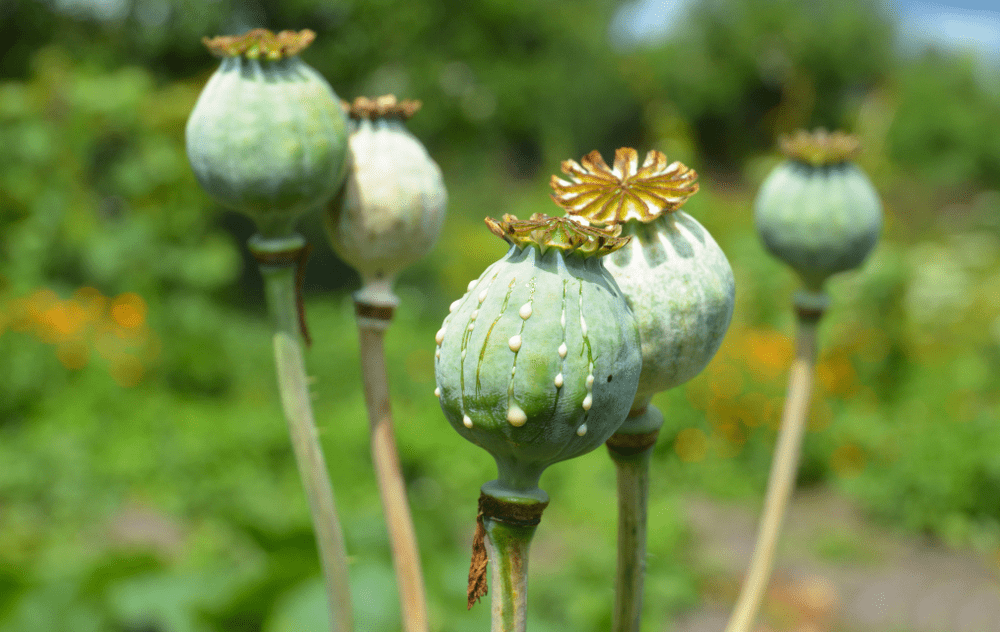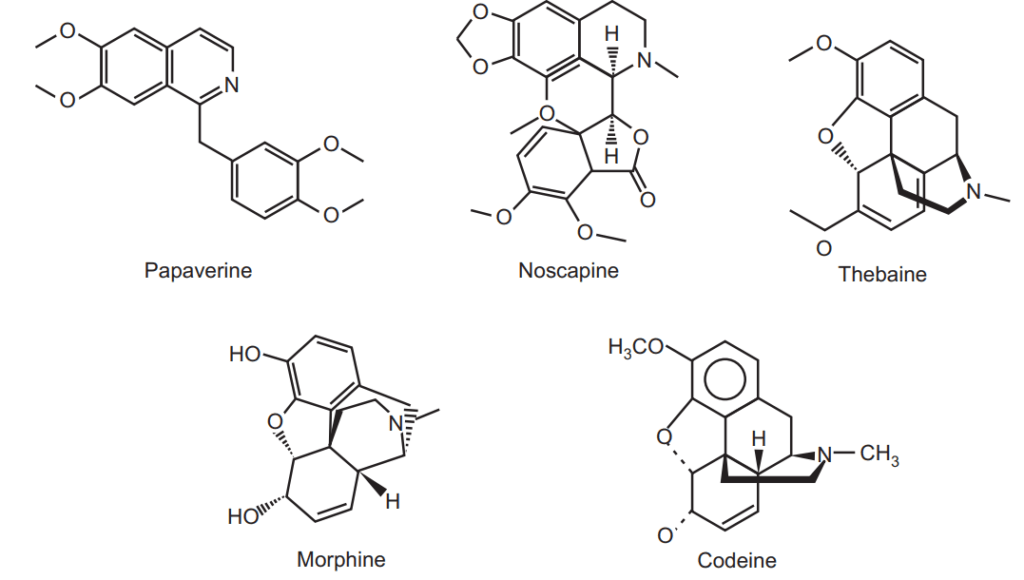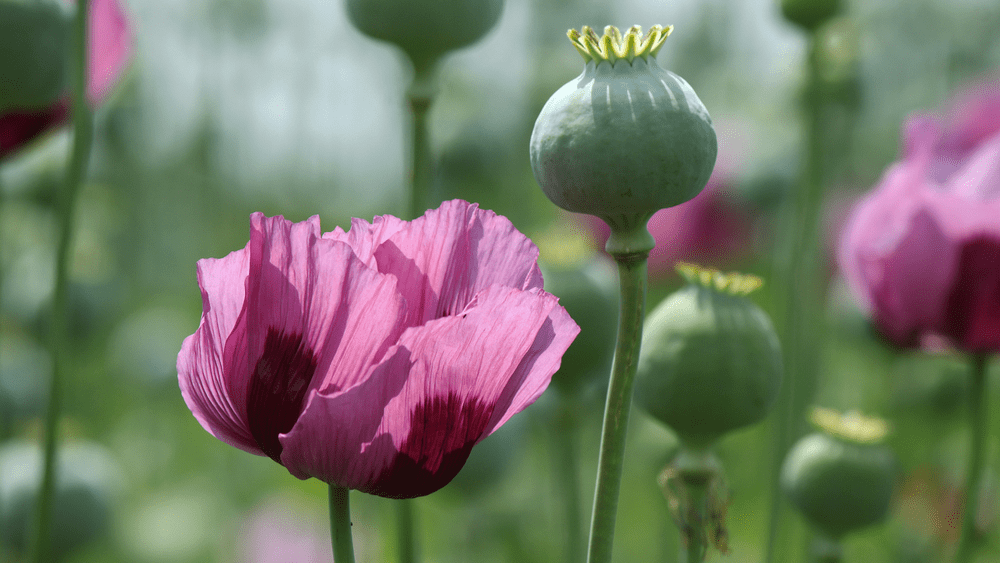Pharmacognosy of Opium, Biological source, morphology, microscopy, chemical constituents, uses, adulterants and substitutes of Opium…
Synonym: Raw opium.
Biological source: The latex is collected from unripe capsules upon incision of Papaver somniferum Linn. The latex is dried fully or partly by heat or spontaneous evaporation. The irregularly shaped masses or moulds of uniform sizes and shapes are found. It contains not less than 9.5 per cent of morphine calculated as anhydrous morphine.
Family: Papaveraceae
Geographical sources: India, Pakistan, Afghanistan, Turkey, Russia, China.
Cultivation, Collection and Preparation
There are more than 50 different species that exist in the genus Papaver. Out of which six species are found in India P. nudicaule, P. rhoeas, P. argemone, P. dubium P. somniferum and P. Orientale.
It is an erect plant having 60-110 cm in height approximately. It is branched having linear-oblong or ovate-oblong leaves, and bluish-white, violet or purplish flowers. Cultivation of opium is mainly done in certain regions like Madhya Pradesh, Punjab, Rajasthan and Uttar Pradesh under government supervision. The yield depends upon weather conditions. It grows well in a temperate climate. It can also grow well in the winter season but extreme cold and frost adversely affect the plant and yield of opium. The cool weather (without freezing temperatures and fog or cloudiness) with full sunshine favours the growth of the plant and gives a better yield. It grows from November to March months. The propagation is mainly done by seed sowing (generally 3-4 kg seeds per hectare are required). The seeds are mixed with sand (1:3) and sown in the soil. The well-drained loamy soil is preferred for cultivation. The soil should have a pH of 7 for better cultivation. Organic matter and fertilizers are supplied for cultivation. The distance should be 25 cm between two plants. The plant reaches up to one-meter height.

During the maturity period, the capsule exudes maximum latex which shows a colour change from dark green to light green. Such capsules are incised vertically in the afternoon with the help of specific needle shape apparatus called Nushtur. Latex exudes out and thickens due to cold weather at night which is eventually scrapped and collected the next morning by an iron scoop called enarpala. The incision is repeated 4 times. Latex is collected in a plastic container. The capsules are collected and dried in open areas and further the seeds are separated by beating.
Macroscopical characters
Odour: Strong, characteristics
Taste: Bitter taste
Table 1.1: Commercial varieties of opium and their appearances
| Sr. No. | Commercial variety | Appearance |
| 1. | Indian opium | Colour: Dark brown Form: Cubical pieces Fracture: Brittle |
| 2. | Persian opium | Colour: Dark brown Form: Brick-shaped masses Nature: Hygroscopic, granular, smooth |
| 3. | Turkish opium | Colour: Brown or Dark brown Form: Conical, rounded or flattened masses |
| 4. | Chinese opium | Colour: Dark brown Form: Globular cake |
Chemical Constituent:
Opium contains more than 30 alkaloids which are largely combined with the organic acid meconic acid. The drug also contains sugar salts, albuminous substances, colouring matter and water. The six principle alkaloids are Morphine, Codeine, Thebaine, Noscapine (also known as narcotine), Narceine, and Papaverine. The first group consist of phenanthrene nucleus (morphine groups) whereas the of papaverine group has a benzylisoquinoline structure. Morphine molecule has both phenolic and alcoholic hydroxyl group and when acetylated forms diacetylmorphine or heroin. Codeine is an ether form of morphine (methyl morphine). Meconic acid is dibasic and easily detected either in its Free State or meconate by the formation of a deep red colour on the addition of ferric chloride. Less important opium alkaloids (protopine and hydrocotarine) are of different structural types.
Chemical test:
- Opium is dissolved in water and filtered. To the filtrate add ferric chloride solution which gives deep reddish-purple colour. This purple colour persists even with the addition of hydrochloric acid indicating the presence of meconic acid which ensures the detection of opium. This test is general for its detection.
- Morphine gives orange-red colour when sprinkled on nitric acid whereas codeine does not give this test.
- Morphine solution develops bluish green colour upon the addition of potassium ferricyanide and ferric chloride.
- Papaverine solution develops a lemon yellow colour with hydrochloric acid and potassium ferricyanide solution.

Uses
It is used as a hypnotic, sedative and analgesic but has addiction properties so given in severe pain or if the patient does not show a response to other analgesics. It stimulates the chemoreceptor zone in the medulla which leads to nausea and vomiting. Codeine (a mild analgesic which is potent as aspirin) relieves local irritation in the bronchial tract and is an antitussive. Papaverine has smooth muscle relaxant activity. Narcotine (or Noscapine) is used in cough preparations due to its depressant action on the cough reflex. Diacetyl morphine also known as Heroin has a more narcotic analgesic effect than morphine.
Adulterants:
The adulterated forms show the presence of Opium capsules in powdered form, gum and sugary fruits. Generally, opium is not found to be adulterated due to the production done under Governmental control.
Allied drugs: Papaver dubium, P. orientate, P. argemone, hybrids of P. somniferum and P. orientate (these species do not possess morphine content).
Make sure you also check our other amazing Article on: Pharmacognosy of Belladonna
